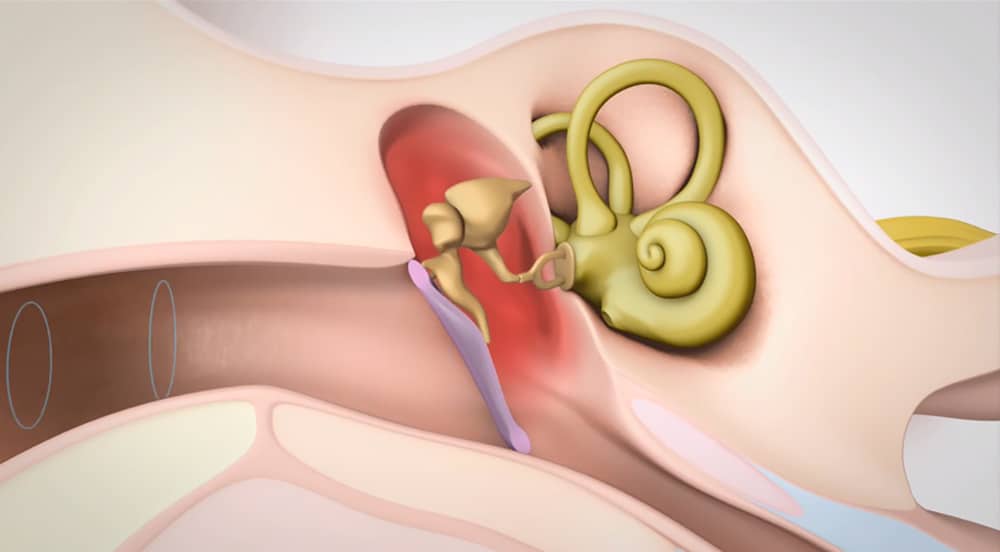MED-EL
Published May 25, 2016
How the Middle Ear Works

The middle ear might have the smallest bones in the human body, but it plays a huge role in hearing. In this post, we’ll dive into this tiny but important part of the body, and find out how the middle ear works.
What Is the Middle Ear?
Behind the eardrum, in the middle ear, you’ll find the tiniest bones in the entire human body: the hammer, anvil, and stirrup.
(The stirrup, for example, is approximately 3 mm long.)
These three bones, often referred to as the ossicles, serve a crucial role in moving sound waves from your outer ear to your inner ear. Without your ossicles, you wouldn’t be able to hear as you do now.
All sound starts as sound waves.
- When a sound wave reaches your ear, it pushes up against the eardrum as vibrations.
- These vibrations go through the eardrum and cause it to push against the hammer, which pushes against the anvil, which pushes against the stirrup.
- The stirrup pushes up against a part of the cochlea called the oval window, transferring the vibrations to the inner ear.
- The vibrations that reach the inner ear will be picked up by hair cells in the cochlea—and become hearing.
If you didn’t have ossicles, sound waves would vibrate your eardrum and oval window with about the same amount of energy. That’s not enough energy to be heard, because the inner ear is filled with a liquid; it takes more energy to move a liquid rather than air. So sound waves alone wouldn’t be able to move the oval window with enough force.
That’s where the ossicles come in. They amplify the movement of the eardrum, which is much larger than the oval window. Just a small movement of the ear drum can turn into a very big movement of the oval window.
What happens after sound reaches the oval window? Check out our blog post about how hearing works.
Conductive and Mixed Hearing Losses
There are many different ways that the middle ear can stop working properly. When that happens, it usually results in hearing loss.
Here are some of the common causes of conductive and mixed hearing losses:
Infections
Middle-ear infections are a common cause of hearing loss. Infections cause fluids to build up in the middle ear, which can slow down the movements of the ossicles and cause sounds to be more difficult to hear. Sometimes the infections resolve themselves, while others can stick around for a longer time.
Otosclerosis
Otosclerosis is when abnormal growth causes the bones of the middle ear to fuse together. This makes the ossicles move less than normal, or not at all, and can severely affect hearing.
Malformations
Sometimes, a person is born with a malformation of their middle ear. A malformation just means that their middle ear is shaped differently than normal. This could mean that the ossicles have a different shape, or some or all of the ossicles are missing.
Hearing Loss Solutions
Depending on the type and severity of hearing loss, there are a number of different solutions.
Someone with hearing loss will usually start by trying hearing aids, which essentially increase the strength of the sound waves being sent into the ear. For some people, this will be enough.
However, it’s possible that someone will find hearing aids to be uncomfortable, ineffective, or physically impossible to use. For these people, the next step is usually a hearing implant: a middle-ear implant or a bone conduction implant.
To learn more about middle ear or bone conduction implants, check out these other blog posts we’ve put together:
- All about our middle-ear implant, the SOUNDBRIDGE
- Patricia got her life back thanks to the SOUNDBRIDGE Middle-Ear Implant
- Why the BONEBRIDGE Bone Conduction Implant is so special
- Sophie fell in love with her BONEBRIDGE implants
Subscribe to the MED-EL blog to get all sorts of useful information about hearing, hearing loss, and more!
MED-EL
Was this article helpful?
Thanks for your feedback.
Sign up for newsletter below for more.
Thanks for your feedback.
Please leave your message below.
Thanks for your message. We will reply as soon as possible.
Send us a message
Field is required
John Doe
Field is required
name@mail.com
Field is required
What do you think?
MED-EL


